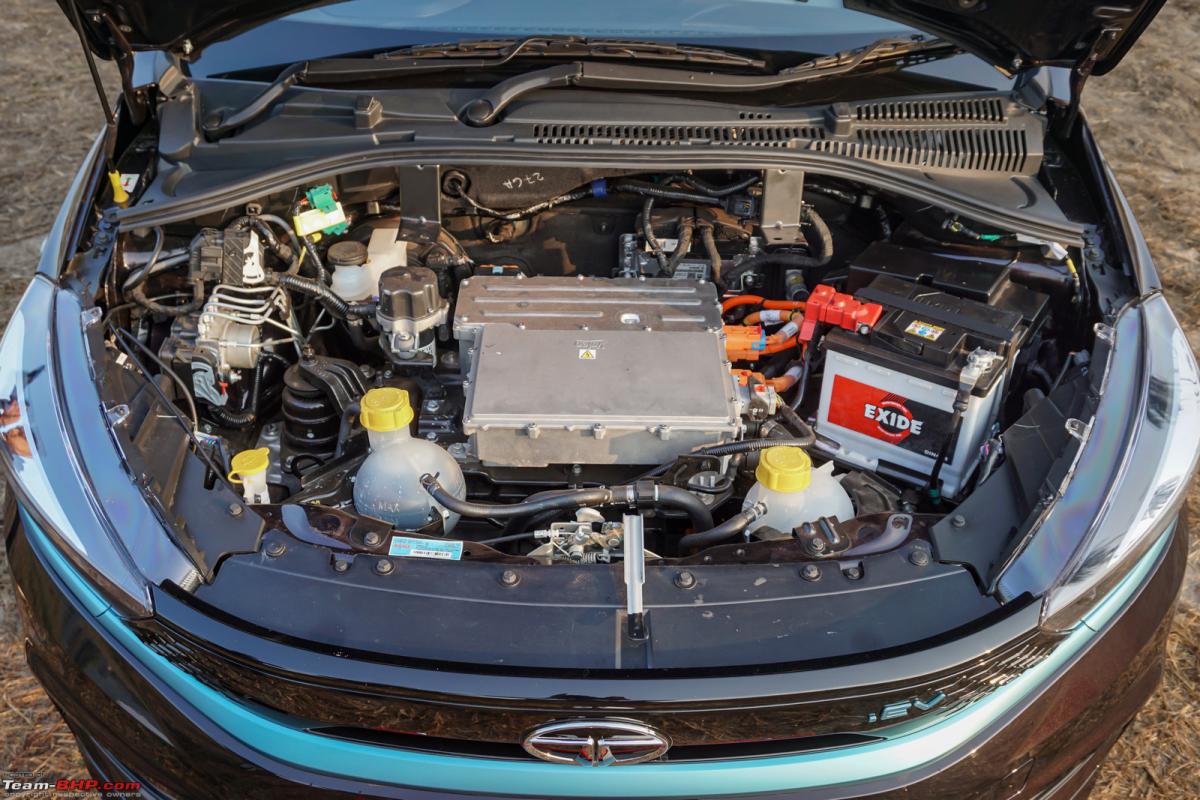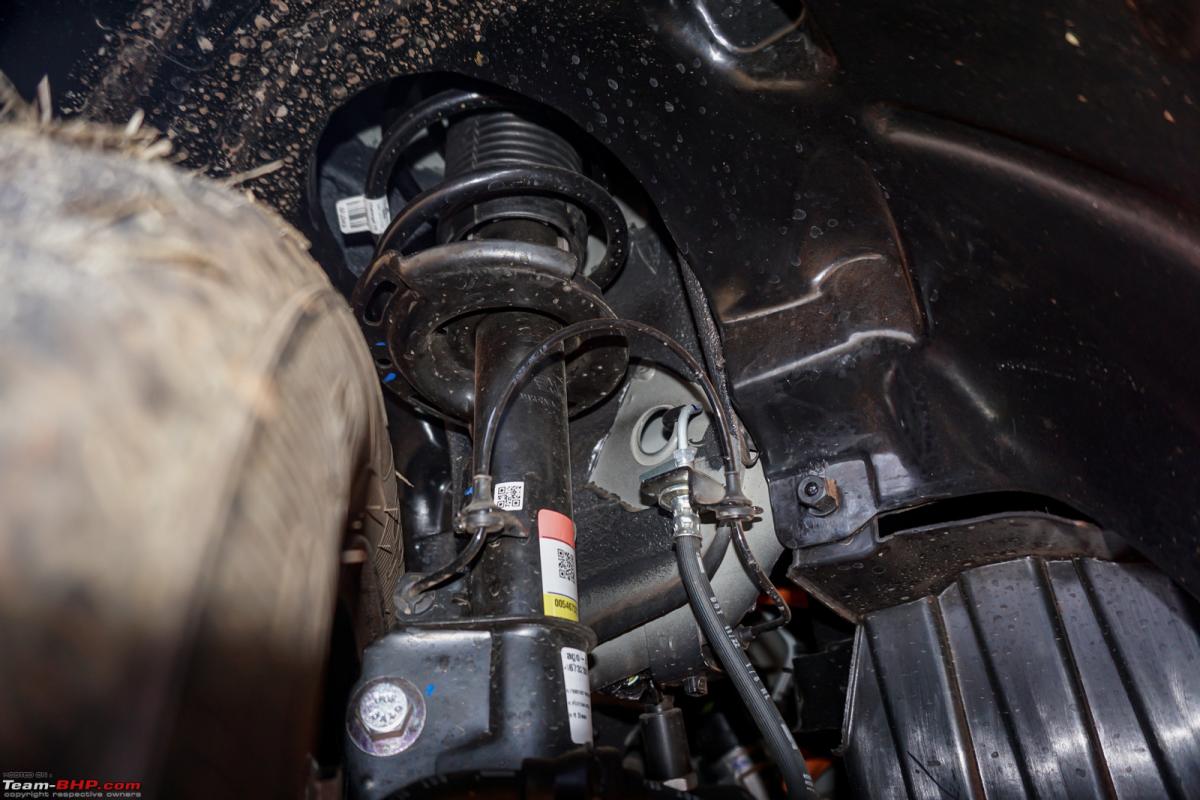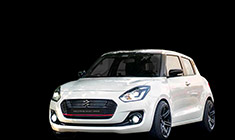News
Tata Tiago Electric: Our observations after a day of driving
If you’re wondering, how it compares to the Tigor EV with the torque deficit, don’t worry. The Tiago EV feels very similar to drive due to the lower kerb weight (86 kg lighter) and the tuning of the motor.
Driving the Tata Tiago EV
The car that we got to drive was the long-range variant with the 24kWh battery pack. It has a Permanent Magnet Synchronous Motor that puts out 74 BHP & 114 Nm of torque:

Before we get to the driving part, let’s get some basics right. There are 3 main components in an EV – the battery, the motor, and the controller/charger. The battery is what stores the energy and the motor is what uses that energy to move the car. The controller/charger converts the energy from the battery into a usable form to power the motor. In more technical terms, the power grid from your house or a charging station is usually an AC current. The lithium-ion battery can store electric energy in DC form. So while charging, there’s an AC/DC converter that will convert the power grid's AC into DC and store it in your car’s battery. The DC fast chargers that you see usually have the AC/DC converter inbuilt, which is how they can charge your car’s battery faster. The controller typically sits on top of the motor. In the case of the Tiago EV, the controller and motor are placed under the bonnet.
The Tiago EV shares its powertrain with the Tigor EV. However, there are a few differences. The torque rating is down by 56 Nm in the Tiago EV. Both have a claimed 0-60 km/h time of 5.7 seconds, despite the Tigor EV being heavier. The tuning is different on both cars and it’s worth noting that the maximum motor rpm of the Tiago EV is higher than that of the Tigor EV. Now, let’s get to the driving part. People driving an EV for the first time will need to get used to the eerie silence after pressing the start/stop button, but it takes just a couple of drives to feel comfortable with it. There are 4 transmission modes to choose from – D, R, N, and S. ‘D’ mode is more designed for city driving conditions, while ‘S’ mode is when you want that extra power (at the cost of FE, which in this case, is the battery charge level). The rotary dial for transmission modes is not very intuitive and a traditional AT gear lever with slots would’ve been preferred. Tata has integrated their recent electric cars with a useful feature to go with this rotary transmission dial. Say you’re at a traffic signal, you no longer have to switch to ‘N’ and pull the handbrake. You can just pull the handbrake in ‘D’ mode and the creep function is disengaged, so the car won’t move. Neat integration, but the customers will have to be educated about this.
As a safety feature, the car will always start in "N" mode. Engage D, take your foot off the brake pedal and the Tiago EV gets off the line in a perfectly smooth manner, crawling at 6 km/h. It’s very linear and without any jerks. Driving around in "D" mode within the city is a super convenient affair. No clutch, no gears, no turbo lag & no noise means even a newbie driver will seem like a smooth one. The motor has sufficient torque, but it is used conservatively in "D" mode for a smoother driving experience & to maximize driving range. Think of "D" being more like "ECO" mode. Performance in D mode is decent, but that's it. You won’t have any issues keeping up with city traffic & power is sufficient for day-to-day commuting. When you want to suddenly accelerate from say 40 - 50 km/h though, you will feel the power deficit & it feels like a 1.2L NA petrol! If you want quicker acceleration, simply switch to "S" mode and you’ll notice a BIG difference in the way the power is put down. The throttle response is much sharper and you get a stronger surge of power. Added bonus = in "S", you'll see the power gauge on the left showing a redline at the limit (via 3 red bars), just like a conventional rev counter.
Out on the open road, D mode is adequate for regular drivers. You can cruise comfortably on the expressway. However, if you need to execute an overtaking manoeuvre quickly, S mode comes in handy. You'll also find yourself engaging "S" mode whenever you are in the mood for some fun. The Tiago EV feels peppy in Sport mode, even on the open road. Power is delivered strongly till 100 km/h, after which it starts to taper off. The Tiago EV's top speed is limited to ~120 km/h and progress from 110 - 120 km/h is quite slow. Must add that electric cars aren't good at high-speed cruising, from the range point of view. Drive continuously at 110 - 120 km/h in "S" mode and you'll see the battery level drop alarmingly fast. That's one of the reasons you'll see most EVs driving at 80 - 90 km/h on the expressway in the middle lane. If you’re wondering, how it compares to the Tigor EV with the torque deficit, don’t worry. The Tiago EV feels very similar to drive due to the lower kerb weight (86 kg lighter) and the tuning of the motor. All in all, it is a smooth car to drive in the city and on the occasional inter-city highway trips at 80-100 km/h.
Regenerative Braking
Remember when we said Tata is updating its cars based on customer feedback? Here’s an example. The Tigor EV that we drove last year didn’t have adjustable regenerative braking. The Tiago EV gets this feature and the latest Tigor EV also has been updated with the addition of adjustable regenerative braking. Way to be proactive Tata Motors! There are 3 levels of regeneration that you can choose from. You can also turn it off completely and depend on the brakes for stopping the car. Driving with maximum level 3 regeneration, you can feel your head nod when you lift off the accelerator. It’s good for maximizing range, but not so good for smooth driving. You can switch to level 1 or 2 for smooth deceleration on lift-off. One-pedal driving is very much possible in the city with level 3 regen as the deceleration is quite strong. However, the car won't come to a complete halt. It will crawl forward and you have to apply the brakes to stop it. This is again an individual preference and we were told that depending on customer feedback, Tata will or will not make the change in the next update. This change will merely be a software update, so it can be incorporated easily.
A thoughtful integration is that in level 3 regeneration and sometimes in level 2 (if the deceleration is strong), the brake lamps light up to let the car behind know that the Tiago EV is slowing down. Another point to note is that the level 3 regeneration will not be as strong when the battery percentage is 85 and above. It’ll show that the car is on level 3, but it won’t decelerate as strongly.
Noise, Vibration & Harshness (NVH)
Well, there’s no engine noise for starters! The only sound coming is a faint whirring by the electric motor. No gearshifts & minimal mechanical parts mean no jerks or vibrations. On the highway, tyre noise starts creeping into the cabin early at 80 km/h. You'll hear it more because there is no engine sound to drown some of it out.
Range
Range anxiety is a big concern with EVs. However, it’s only when you are pushing the car hard that you'll notice the range and battery percentage falling at a rapid pace. Tata Motors claims that under standard test conditions the Tiago EV has a range of 315 km, but under normal driving conditions, you can expect a range of ~200 km. This is enough for those intending to drive primarily in the city.
The range displayed on the MID varies based on the driving style of the previous driver. So, we couldn’t depend on the range readout on our test drive. There’s another useful bit of information on the MID next to the speedometer marked as ‘AEC’ which stands for average energy consumption and has a Wh/km reading. We managed to get around 140 Wh/km with ~60% driving in S mode and 40% sedate driving with maximum regeneration. If you want to calculate what that translates to in range, just divide 24,000 (24 kWh battery capacity) by the AEC reading. In this case, we got ~171 km of range, which is not bad considering the amount of time we spent in S mode. Keep the AEC number close to 120 Wh/km and that should translate to ~200 km of range which seems doable.
Charging
Tata Motors has been working with its sister company, Tata Power, to improve the charging infrastructure levels. Also, there are multiple independent players popping up with charging stations everywhere. That said, we can tell you that the best place to charge your EV is at home. Cheapest + most convenient. At an average cost of Rs. 8 per unit, you’ll be paying Rs. 192 for a full tank at home. The estimated charging time (10% to 100%) from a 15A plug is around 8.7 hours. You can opt for the 7.2kW AC charger at your home or office for Rs 50,000 to bring down the charging time to 3.6 hours. A DC fast charger would top up the charge from 10% to 80% in just under an hour.
Suspension

Ride Comfort
The Tiago EV gets a MacPherson strut suspension with dual-path struts at the front and a twist-beam suspension at the rear. It rides on 14-inch rims shod with 175/65 section tyres. The recommended tyre pressure rating is 33 PSI all around.
Like most fossil fuel cars converted to electric, the Tiago EV's suspension has been stiffened up due to the heavy battery pack it is carrying. You'll notice the firmer suspension as soon as you start driving the car. Over some mildly uneven roads in the city at slow speeds, there is a fair bit of movement in the cabin and it even feels jiggly at times. However, the suspension is quite absorbent at low speeds and you can carry some speed over rough roads. You feel more of the road in the Tiago EV, but still, the ride quality is liveable & compliant enough on most city roads. It's only the really big bumps that come in strong, as do the sharp road dips. On the other hand, the Tiago EV rides rather flat on the expressway. At high speeds, i.e. 100 km/h, you have to be careful of the road undulations and expansion joints.
Handling & Dynamics
There are a couple of things that aid the handling characteristics of the Tiago EV. Firstly, it’s the firmer suspension, and secondly, the heavy mechanicals (battery pack + motor) that lower the center of gravity. High-speed stability is very good and you’ll be doing 110 - 120 km/h on the expressway without feeling nervous at all.
Get on some twisty roads and you’ll appreciate the stiffer suspension. The car feels agile and you can carry good speed into corners. The suspension setup does complement the chassis well and the Tiago EV holds its line nicely. Changing direction on back-to-back corners is no problem either. You will like how the EV feels well-balanced in corners. In comparison to the Tigor EV, you don’t have the additional weight on the rear axle which is why it feels a tad bit more composed. Earlier, I had apprehensions that the heavy battery pack might cause some imbalance, but we didn't face any problem on our (admittedly) limited test drive. The only issue is the 175/65 section rubber, which is meant for maximizing range and not for pushing hard into corners. You will hear the tyres chirp when powering out of tight corners.
Steering
The electric power-assisted steering is a nice unit and is super light at parking speeds. The turning radius of 5.1 m is user-friendly and you can manoeuvre the car easily with gentle inputs on the steering. It weighs up adequately as you gain speed. It also has that typical trait in Tata’s steering where the weight is not added gradually. At ~50 km/h, you will notice that the steering wheel suddenly gets heavy. Very weird! The EPS is dead and there’s not much feel or feedback from it.
Braking
The Tiago EV gets disc brakes at the front and drum brakes at the rear. Their performance, in general, is satisfactory. However, we feel that wider tyres would definitely improve the braking performance of the car. Another sore point is that, like most EVs, the brake pedal has a spongy & rubbery feel. It feels weird at first, but you will get used to it.
Continue reading the discussion on the 2022 Tata Tiago Electric on our forum.


















